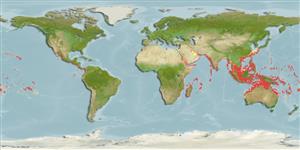Common names from other countries
>
Anguilliformes (Eels and morays) >
Muraenidae (Moray eels) > Muraeninae
Etymology: Gymnothorax: Greek, gymnos = naked + Greek, thorax, -akos = breast (Ref. 45335).
More on author: Lacepède.
Environment: milieu / climate zone / depth range / distribution range
Ecologia
marino; salmastro associati a barriera corallina; distribuzione batimetrica 1 - 110 m (Ref. 58302). Tropical; 32°N - 28°S
Indo-Pacific: Red Sea and East Africa, including Walters Shoal (Ref. 33390) and Persian Gulf (Ref. 68964) to French Polynesia, north to southern Japan and the Hawaiian Islands, south to the southern Great Barrier Reef. Eastern Central Pacific: Costa Rica and Panama (Ref. 9324).
Length at first maturity / Size / Peso / Age
Maturity: Lm ?, range 77 - ? cm
Max length : 150 cm TL maschio/sesso non determinato; (Ref. 1602)
Short description
Morfologia | Morfometria
Spine dorsali (totale): 0; Raggi dorsali molli (totale): 0; Spine anali 0; Raggi anali molli: 0; Vertebre: 126 - 138. Distinctive pattern of light undulating lines and speckles on a dark green background. Snout often yellow (Ref. 30404).
A common species on reef flats among rocks, rubble, or debris and also occurs in lagoons and seaward reefs to depths of 26 m or more. Minimum depth of 1m (Ref. 81209). Cavernicolous (Ref. 8593, 58302). Benthic (Ref. 58302). Nocturnal species that feeds on fishes, octopi, and probably crustaceans. Reported to be an aggressive species and prone to bite. Used in Chinese medicine (Ref. 12166).
Life cycle and mating behavior
Maturità | Riproduzione | Deposizione | Uova | Fecundity | Larve
Chen, H.-M., K.-T. Shao and C.T. Chen, 1994. A review of the muraenid eels (Family Muraenidae) from Taiwan with descriptions of twelve new records. Zool. Stud. 33(1):44-64. (Ref. 6934)
IUCN Red List Status (Ref. 130435)
CITES (Ref. 128078)
Not Evaluated
Threat to humans
Reports of ciguatera poisoning (Ref. 4690)
Human uses
Pesca: scarso interesse commerciale; Acquario: Commerciale
Informazioni ulteriori
BibliografiaAcquacolturaProfilo di acquacolturaVarietàGeneticaElectrophoresesEreditarietàMalattieElaborazioneMass conversion
Strumenti
Special reports
Download XML
Fonti Internet
Estimates based on models
Preferred temperature (Ref.
115969): 24.3 - 29, mean 28 (based on 1810 cells).
Phylogenetic diversity index (Ref.
82804): PD
50 = 0.5000 [Uniqueness, from 0.5 = low to 2.0 = high].
Bayesian length-weight: a=0.00065 (0.00041 - 0.00103), b=3.28 (3.15 - 3.41), in cm Total Length, based on LWR estimates for this species & Genus-body shape (Ref.
93245).
Trophic level (Ref.
69278): 3.6 ±0.3 se; based on diet studies.
Resilienza (Ref.
120179): Molto basso, tempo minimo di raddoppiamento della popolazione più di 14 anni (Preliminary K or Fecundity.).
Fishing Vulnerability (Ref.
59153): Very high vulnerability (90 of 100).
